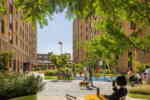Sendero Verde
Sendero Verde offers 709 affordable units in the world's largest Passive House residential building.
Sendero Verde is a transformative development in New York City’s East Harlem that is a vibrant mix of affordable housing and community services. The development serves 700+ families with incomes ranging from formerly homeless to 110% of the area median income.
Sendero Verde was the winner of the SustaiNYC RFP in 2017, which required that the final design be certified to Passive House standards, a rigorous building energy standard that achieves a 40-70% reduction in building energy as compared to a typical building. Sendero Verde is now the largest Passive House residential building in the world.
Sendero Verde was conceived of as a “Community of Opportunity” that would pair an extremely healthy building with access to high-quality schools, health care, transportation options, jobs, and open spaces. Harlem Children Zone operates here, as well as the services provider Union Settlement, in one of the first Family Enrichment Centers in Manhattan. A grant for formerly homeless residents provides robust social services and case-management.
In taking a cue from an historical trail that once crossed through the site, the project is arranged around a central meandering landscaped path, which weaves through the project from Park Avenue to the western end of 111th Street and Madison Avenue. The massing is broken down into three separate volumes which frame this path, creating a central courtyard. This courtyard spills out onto different levels, creating opportunities for individual community gardens.


The concept behind Sendero Verde is that by providing a variety of opportunities and support services under one roof, we can work to break the cycle of poverty that disrupts so many people’s lives.
This "Community of Opportunity" is woven throughout the project and is reflected in both the types of spaces that are offered, and in how those spaces are arranged. Each intrinsic program element retains its own individuality, but because of their juxtaposition and linking, yields something greater.

The building’s architecture integrates with the existing urban fabric, echoing the brick surroundings of East Harlem while reflecting its vibrant cultural history through pops of color.
The articulation of the building’s façade echoes the underlying design concept: subtle color variation as well as pushing and pulling of the façade allow the façade to visually recede and project, as well as create shadow lines and visual richness.
Outdoor amenities include an 18,000 SF Publicly Accessible courtyard park and three NYC GreenThumb Community Gardens, all accessed from entrances on Park and Madison Avenues, as well as by residents directly from the 2nd floor.
The community gardens and landscaped pathways connect residents to nature and each other, reinforcing a sense of belonging. This included relocating the equivalent square footage from four distinct informal gardens on the site into the design. Two of the gardens combined operations in that process, resulting in three garden spaces that now flank and augment the publicly accessible central courtyard. This not only honors the site’s history as an informal garden but also provides publicly accessible greenspace for the community.






Residential entrances include large expanses of glass, framed in black metal.
There are a total of three residential entrances. The warm wood paneling of the lobbies is carried into the awning of each entrance.
Interiors are clean and modern and use economical materials like wood veneer and tile in order to imitate more expensive materials, while still creating a sense of sophistication and warmth.
Portions of the lobby walls and ceilings are clad with bent planes of wood paneling, while elevator cores are clad in a large format tile designed to imitate corten steel panels. Light concrete colored flooring is paired with colorful biophilic rugs that demarcate spaces for hanging out or waiting.


Indoor building amenities include community lounges, a computer room, fitness spaces, and party rooms, all free to residents.
All amenity spaces have a visual or physical connection to the outside. Vibrant paint colors and wallcoverings provide an energy to match the function of each space. Free wifi is provided throughout the building.

Sendero Verde is Passive House certified, which resulted in increased up-front costs but will reduce operation costs for tenants and the building owner by reducing thermal energy demand by up to 60% compared to a comparable building.
In order to meet both the high-performance requirements and the constrained budget, the design team had to devise and apply inexpensive air-tight enclosure designs previously untested on high-rise construction. This helped the team to achieve the levels of affordable rents required and still achieve Passive House certification. The design team worked with the construction team early in the process to ensure that the Passive House details were as close to typical construction practices as possible, so that they would be well executed in the field.
Sendero Verde exemplifies how sustainability and large-scale affordable housing can coexist, aligning with New York City’s climate goals and demonstrating the feasibility of sustainable practices in dense urban environments.
Sendero Verde: Designing the World's Largest Passive House Residential Building
Discover how Sendero Verde sets a new standard for affordable housing through resident-centered design and groundbreaking energy performance.
View Case Study
